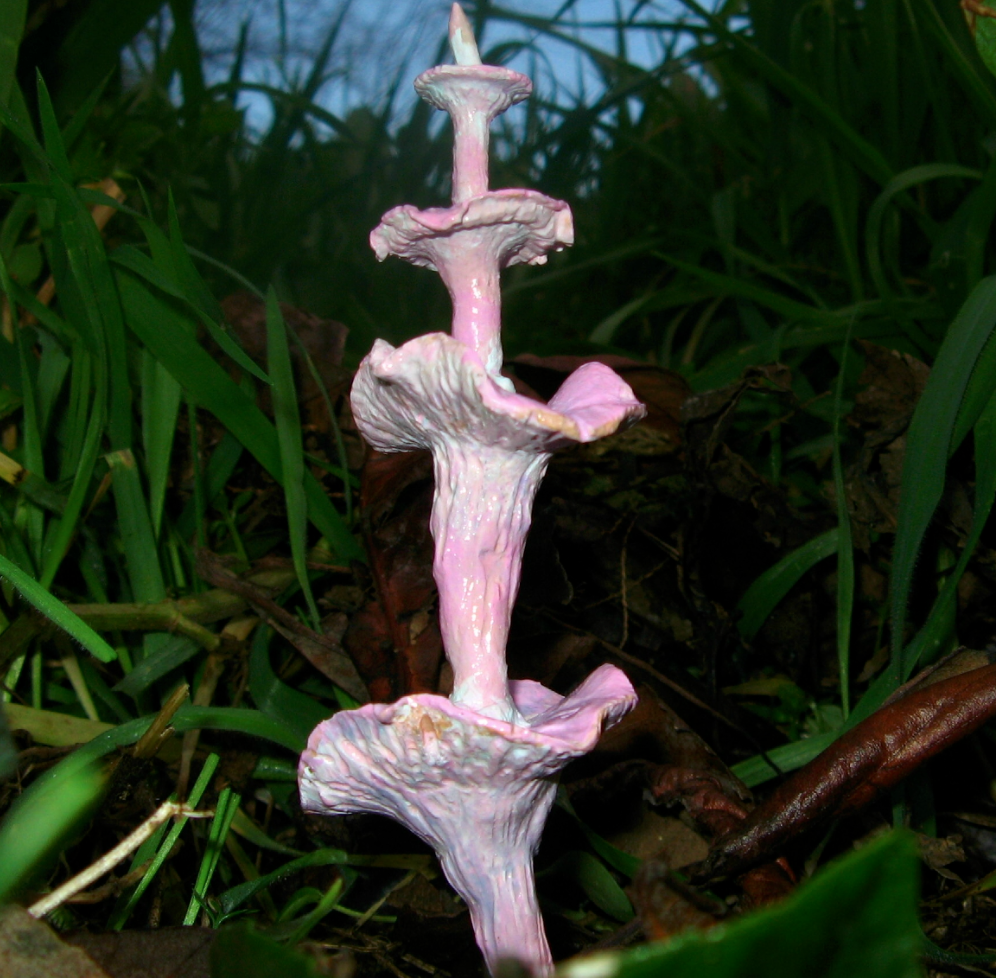Sometimes, I find myself using these Fungi Fridays as an escape. When the frigid weather gets me a bit down, I like to find a tropical, bizarre-looking fungus to remind me that in other parts of the world, the forest floor is teeming with life. When you truly immerse yourself into forest ecology and live in a temperate part of the world, around this time of year, you get antsy. I came across such a cool species that brightened my spirit, filling me with optimism and wonder. I’d like to share this species with you today. Podoserpula pusio is a fascinating looking fungus that grows in New Zealand, Australia, New Caledonia, Venezuela, and Madagascar.
Podoserpula pusio var. pusio by J.J. Harrison.
Fittingly named the pagoda fungus, this species has several stacked tiers of fruiting structures that branch off a central stalk. Outside of its family, there isn’t a single other species within the massive fungal kingdom that has this morphology. This just goes to show that evolutionary success can come in an incredible array of form and function. Podoserpula pusio is one of just two species that represent its exceedingly small family, the Amylocorticiaceae. Although there are just two species within this family, today’s featured fungus actually has four separate variations. You might be wondering why these different varieties aren’t just designated as separate species. Clarifying these discrepancies is at the heart of modern fungal phylogeny, and for now, their genomes are considered too similar to separate them into distinct species. The four varieties found are Podoserpula pusio var. pusio, var. austro-americana, var. ellipsospora and var. tristis. Its closest relatives look nothing like the intricate pagoda-like fruiting body, as they are made up of resupinate crust fungi that grow in a simple fashion beneath horizontally oriented logs and branches. When you look at the species preferred substrate, its morphology is better understood.
A five story pagoda in Japan.
Unlike the other crust fungi in its Amylocorticiales order, Podoserpula pusio breaks down the organic plant material from well-rotted stumps and tussock grass, which are both located on the ground. Its relatives specialize in less decomposed woody substrates that are elevated from the forest floor. Podoserpula pusio still has maintained a saprophytic ecology, but it has shifted from its ancestral, resupinate elevated substrate, to the ground. A crust morphology is a useless form when growing from the ground, because here, less wind can disperse a species spores. This is the reason toadstools evolved-to escape the still, boundary layer from the forest floor to adequately disperse potential offspring.
The closely related resupinate crust fungus Ceraceomyces sublaevis.
With specializing in a separate substrate, over millennia, this species evolved this really cool stacked morphology. The pagoda fungus escapes the still air just above the forest floor to maximize spore dispersal. When you look at the underside of this fruiting body, beneath these cap structures you can’t help but make the connection that its closely related to fungi with resupinate morphology. There aren’t symmetrical gills or pores, but a series of irregular bumps and folds, much like many other crust fungi I find. Even more interesting to me, is when I researched the only other species within its family, Podoserpula miranda. Like Podoserpula pusio, P. miranda too grows from the forest floor. Only instead of breaking down dead plant parts, it forms a symbiotic relationship with living ones. That’s right, in New Caledonia P. miranda forms ectomycorrhizal relationships with a tree endemic to the area, Arillastrum gummiferum.
The bizarre, ectomycorrhizal fungus Podoserpula miranda. By Jean pierre Piétri.
This fungus has infiltrated my mycological spirit on this cold and dreary day in Western New York. I can’t wait for the forest floor to thaw out so life can reclaim the largely inactive ecosystems in my area. In the meantime, I know that there is still so much to learn. Podoserpula pusio has without a doubt made me appreciate life on Earth. The evolutionary trajectory of this species blew me away, as it switched its lifestyle from a resupinate saprophytic form growing on elevated branches and logs to more decomposed substrate located on the forest floor. With this switch, it evolved a stacked morphology to escape the still boundary layer just above the ground, so wind could transport its spores to other suitable substrates. The ancestor of this family that moved to the ground, diverged into the saprotroph featured here today, as well as P. miranda. The latter species paired with an ectomycorrhizal plant which shows the inevitability of forming mutualists with other species one co-occurs with. Fungi represent a kingdom with so much plasticity, so much adaptability, that I find it hard not to fall in love with them.






